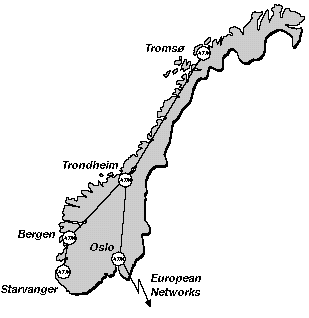
The ATM network in Norway

by Marit Natvig and Eric Swane
Communities scattered all over a long and narrow country, long traditions for democracy and cooperation in the business community, and a high degree of computerization makes cooperation technologies interesting, natural and obvious in Norway. For SME's working together and for large companies with geographically distributed departments, Computer Supported Cooperative Work (CSCW) is a research and development field that will prove to be crucial to companies wishing to remain competitive.
SINTEF is participating in several projects within the field of CSCW. The projects have broad industry participation and are concerned with the early deployment of these new technologies into real work-environments. SINTEF has "taken its own medicine" and has introduced desktop conferencing in order to improve communications between the departments in Oslo and Trondheim (500 km apart). The user oriented approach to CSCW has given SINTEF a unique knowledge of the requirements, the current capabilities, and the long term possibilities of these technologies.
MNEMOS - Corporate memory
MNEMOS is a EUREKA project with emphasis on corporate memory. The project aims at developing methods and tools for enterprise modelling and the exploitation of such models. In addition models for acquisition, representation, and retrieval of knowledge assets in organisations are being developed. Methods and tools are generic and tested in several participating companies.
Currently there are four Norwegian and four French participants, but partners from UK, The Netherlands, Belgium and Hungary are expected to join in the near future.
Expected outcome from the project:
The MNEMOS project team has to a certain extent modeled its own activities and information flows and is using World Wide Web (WWW) as a means of accessing its own database.
BEST - Experiences with asynchrounous co-operation technologies
In the BEST program six large companies within the oil, engineering and finance business areas are working with SINTEF and The Norwegian Institute of Technology (NTH) on the exploitation of existing and new technologies for co-operation. The main activities have been related to Business Process Reengineering (BPR), workflow management and support for information access and exchange.
The companies in BEST are each facing much the same problems related to information maintenance, access and flow. Mutual exchange of experiences and solutions is therefore a main activity within the project. This information exchange will soon be supported by a replicated document archive system shared between the companies and the research partners.
Solutions supporting asynchronous collaboration have until now been given most attention in BEST. But the importance of real time conferencing is established. BEST is one of the financial sources for the BATMAN project, described below, which is adressing real time collaboration, especially by means of desktop conferencing.
BATMAN - Desktop conferencing and high capacity networks
BATMAN is a project with participation from SINTEF, The Norwegian Institute of Technology (NTH) and several companies of varied size, representing both telecom, user and supplier interests.
The objectives of BATMAN are mainly to:
The state-of-the-art within desktop-conferencing has been explored with respect to commercial solutions, research and standardisation. The technical, functional and usage requirements for these tools have been formulated in a report. Solutions based on PC's, and ISDN and TCP/IP communication have been selected, purchased and taken into use. A high-end solution based on ATM is currently assembled.
An important activity is setting up different types of pilots in various organizations. The pilots will be analysed according to a set of evaluation criteria in order to learn more about the introduction strategies and processes, technical and social issues, influence on work patterns, etc.
BATMAN also aims atfinding ways of supporting teamwork in the kind of projects, upon which SINTEF organization itself is based. The integration of asynchronous and synchronous collaboration is also an important topic. By analyzing the processes in more or less structured scientific projects we think it is possible to identify a general usable model for the activities in projects, at least the kind we study. This is taking a BPR (Business Process Reengineering) approach on project work. The resulting model will constitute the foundation for a generic solution for the support of project teams, integrating existing systems and both asynchrounous and realtime colloboration tools. Research in this direction seems to be scarce, and we believe that there is much to be obtained by adressing the area.
Broadband communication is another important aspect of BATMAN. We are about to establish a local ATM network that will be connected to the national ATM testnet. An ATM desktop-conferencing demonstrator will be established over this infrastructure.

CSCW Information Base
T-BOOK, which is an acronym for Telematics Application Engineering Information Base, is a project within the EU Telematics Application program. The objective is to generate a body of knowledge for telematics users and application developers.
The project is collecting information taking into account user requirements, current and future applications, and recent developments and trends. This information will be use to produce the most feasible, efficient and conformant guidelines and recommendations.
The project conducts:
SINTEF DELAB is responsible for the parts dealing with CSCW and multimedia documents, among others.